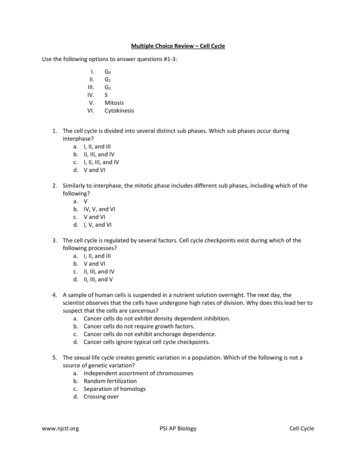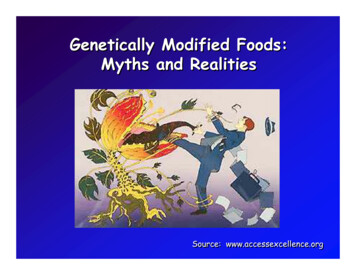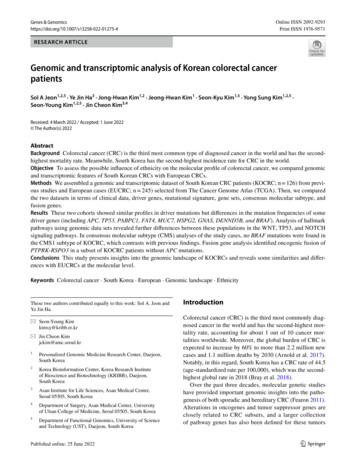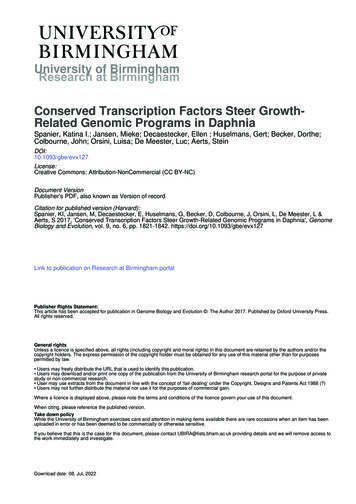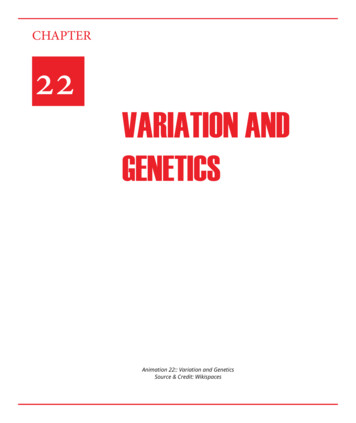
Transcription
Gui et al. World Journal of Surgical (2021) 19:111RESEARCHOpen AccessOverexpressing PTTG family genes predictpoor prognosis in kidney renal clear cellcarcinomaYonghui Gui, Xueni Liu, Chao Wang and Peng Yang*AbstractBackground: Pituitary tumor transforming genes (PTTG1, PTTG2, and PTTG3P) play key roles in the pathogenesisand development of human cancers. The studies show that overexpression of the PTTG genes is associated withtumor progression and migration. However, the function of the PTTG genes in the prognostic value of kidney renalclear cell carcinoma is rarely known by people.Methods: The expression of PTTG family genes was analyzed by the ONCOMINE, Human Protein Atlas, GEPIA2, andUALCAN database. The relationship between PTTG family genes expression level and clinical indicators includingprognostic data in kidney renal clear cell carcinoma was analyzed by GEPIA2, TCGA portal, and UALCAN. cBioPortaldatabase was used to analyze the genetic mutations of differentially expressed PTTG family members. Similar genesof the PTTG family (90 in total) obtained from GEPIA2 and Metascape were used for GO enrichment to explore theinteraction among similar genes. The online tools of Metascape and STRING were used for functional and pathwayenrichment analysis.Results: PTTG1, 2, and 3P mRNA and protein expression upregulated in kidney renal clear cell carcinoma kidneyrenal clear cell carcinoma patients compared with normal tissues. And higher expression level of PTTG family geneswas associated with shorter overall survival (OS) and disease-free survival (DFS). Furthermore, overexpression of thePTTG family genes had been found correlated with individual cancer stages and pathological tumor grades. Inaddition, 18% of mutations in the PTTG family genes were associated with short-term survival in kidney renal clearcell carcinoma patients.Conclusions: A single PTTG gene or PTTG family genes as a whole may be a potential prognostic biomarker forkidney renal clear cell carcinoma.Keywords: PTTG, KIRC, Prognostic, Biomarker* Correspondence: yangpeng00812@163.comDepartment of Blood Transfusion, The First Affiliated Hospital of AnhuiMedical University, 218 Jixi Road, Hefei 230032, Anhui, China The Author(s). 2021 Open Access This article is licensed under a Creative Commons Attribution 4.0 International License,which permits use, sharing, adaptation, distribution and reproduction in any medium or format, as long as you giveappropriate credit to the original author(s) and the source, provide a link to the Creative Commons licence, and indicate ifchanges were made. The images or other third party material in this article are included in the article's Creative Commonslicence, unless indicated otherwise in a credit line to the material. If material is not included in the article's Creative Commonslicence and your intended use is not permitted by statutory regulation or exceeds the permitted use, you will need to obtainpermission directly from the copyright holder. To view a copy of this licence, visit http://creativecommons.org/licenses/by/4.0/.The Creative Commons Public Domain Dedication waiver ) applies to thedata made available in this article, unless otherwise stated in a credit line to the data.
Gui et al. World Journal of Surgical Oncology(2021) 19:111BackgroundRenal cell carcinoma (RCC) is one of the most common malignancies in the world, accounting for 4.2% of all new cancer cases, with an estimated 73,820 new cases in the USA in2019. The incidence and mortality of kidney cancer are nowsteadily increasing, especially with kidney renal clear cell carcinoma accounting for 75% of all kidney cancers [1, 2]. Kidney renal clear cell carcinoma is the most common renalcell carcinoma. However, patients with kidney renal clearcell carcinoma usually have poor prognosis due to limitedbiomarkers for early detection and prognosis prediction [3].ADC value measured by 3T is associated with prognosticparameters of retinoblastoma and lung cancer [4, 5], but itis expensive. Comparatively, bioinformation mining can bequickly and freely available. Considerable efforts have beenmade to study the mechanism of the occurrence, development, and metastasis of kidney renal clear cell carcinomadisease. However, the molecular characterization of kidneyrenal clear cell carcinoma remains unknown. In order to improve prognosis, reliable biomarkers must be found to identify high-risk kidney renal clear cell carcinoma patients whoneed treatment and intervention.PTTG consists of two genes with protein productsPTTG1 and PTTG2, and a processed pseudogenePTTG3P, which has been described in the context of carcinogenesis [6]. Overexpression of PTTG was reported inmany cancers, such as lung, gastric, kidney, pancreatic,breast cholangiocarcinoma, psoriasis, adrenocortical carcinoma, hepatocellular carcinoma, glioblastoma, esophageal squamous cell carcinoma, and prostate cancer [7–15].Therefore, the PTTG family genes not only act as prognostic signatures but also become druggable targets forcancer therapy. Even though extensive researches havebeen conducted to investigate the role of PTTG familygenes in human malignant tumors, the utility of the PTTGfamily genes for the kidney renal clear cell carcinomadiagnosis and prognosistic role of PTTG deletion in kidney renal clear cell carcinoma remains unclear.In this paper, the association between PTTG expression and its diagnostic as well as prognostic value in kidney renal clear cell carcinoma was investigated. Inaddition, potential molecular pathways were revealed forkidney renal clear cell carcinoma through analyzing thegene interaction network by obtaining similar genes.MethodsONCOMINEONCOMINE database (www.oncomine.org) is an integrated online cancer microarray database used for DNAor RNA sequence analysis and for facilitating gene expression analysis and discovery [16]. In this study, transcriptional expressions of PTTG members amongdifferent cancer tissues and their corresponding adjacentnormal control samples were obtained fromPage 2 of 11ONCOMINE database. Difference of transcriptional expression was compared by Students’ t test. The cut-offvalues for p value and fold change are as follows: p value,0.05; fold change, 1.5; gene rank, 10%; data type, mRNA.UALCANUALCAN (http://ualcan.path.uab.edu) is an interactive webresource based on level 3 RNA sequences and clinical datafrom 31 cancers in the TCGA database. It is mainly used toanalyze the relative transcriptional expression of a gene between tumor and normal samples, and the correlation athological parameters [17]. In this study, UALCANwas used to analyze the mRNA expressions of PTTG familymembers in kidney renal clear cell carcinoma tissues, aswell as their association with clinicopathologic parametersand tumor grades, as well as individual cancer stages. Thecutoff of p value was set as 0.01 in the Student’s t test.Human Protein AtlasThe Human Protein Atlas (https://www.proteinatlas.org) includes nearly 20 kinds of immunohistochemical expressiondata of common types of cancer, in which each tumor typeincludes 12 individual tumor sites [18]. Users can identifyproteins which are differentially expressed in a particulartumor type. In this study, the protein expression of differentmembers of the PTTG family in normal tissues and in kidney renal clear cell carcinoma tissues was compared.cBioPortalcBioPortal (http://www.cbioportal.org) is an online accessdatabase used to explore cancer genomic data from multiple perspectives [19]. The gene mutation and survivaldata derive from 510 kidney renal clear cell carcinomasamples in the TCGA database in cBioPortal. The z-scorethreshold of mRNA Expression (RNASeq V2 RSEM) setas 1.8 was also applied to explore the relationship amongthe genetic alterations in PTTG family members and theoverall survival of kidney renal clear cell carcinoma patients. P value was accepted when it is less than 0.05.TCGAportalTCGAportal (www.tcgaportal.org) is an online portalallowing parallel comparisons of multiple tumors anddetailed analysis of individual tumors, which was used toview survival information in the PTTG family and crossverify with other sites.GEPIA2GEPIA2 (http://gepia2.cancer-pku.cn/#index) is an openaccess dataset used to analyze RNA sequencing expression data from 9736 tumors and 8587 normal samples ofTCGA. In this study, the top 30 genes which were similar to the PTTG family in kidney renal clear cell
Gui et al. World Journal of Surgical Oncology(2021) 19:111carcinoma were selected by using the similar gene detection module. After removing the repeated genes, 90genes were reserved for further analysis. The cutoff of pvalue was set as 0.05 in Student’s t test.MetascapeMetascape (http://metascape.org/gp/index.html#/main/step1) is a database which collects data from more than 40independent knowledge bases combined with rich features, interaction analysis, gene annotation, and membersearch. Additionally, it facilitates the comparative analysisof multiple independent and orthogonal experimentsacross data sets by the portal [20]. The GO module can beused to analyze the functional roles of genes related toPTTG family members in biological processes (BP), cellular components (CC), and molecular functions (MF), andKEGG pathways of the PTTG family members.STRINGSTRING (http://string-db.org) is a database that collects,aggregates, and scores publicly available data to explorepotential protein interaction networks. PPI network wasPage 3 of 11generated by STRING from members of the PTTG family genes and their similar genes.Statistical analysisRelated statistical analysis about the correlation betweenmRNA expression of PTTG family members and individuals’ survival status with kidney renal clear cell carcinomawas conducted by SPSS (version 23.0). The meaningfulparameters were reserved when patients’ clinicopathological parameters and mRNA expression of PTTGs had asignificant correlation (p 0.05) for further multivariateanalysis. P value was accepted when it is less than 0.05.ResultThe mRNA and protein of the PTTG family gene isoverexpressed in patients with kidney renal clear cellcarcinoma diseaseTo explore distinct prognostic and potential therapeuticvalue of different PTTGs in kidney renal clear cell carcinoma patients, mRNA expression and protein expressionwere analyzed by ONCOMINE database, UALCAN, andHuman Protein Atlas. As shown in Figs. 1 and 2, mRNAFig. 1 Transcriptional expression of PTTGs in 20 different types of cancer diseases (a). Difference of transcriptional expression was compared bystudents’ t test. Cut-off of p value and fold change were as follows: p value, 0.01; fold change, 1.5; gene rank, 10%; data type, mRNA. Significantchanges of PTTGs expression in transcription level between KIRC and normal tissues (ONCOMINE) (b-j)
Gui et al. World Journal of Surgical Oncology(2021) 19:111Page 4 of 11Fig. 2 mRNA expression of distinct PTTG family members in KIRC and adjacent normal tissues (UALCAN). mRNA expressions of PTTG familymembers were found to be over-expressed in primary KIRC tissues compared with normal samples (a-c). *p 0.05, **p 0.01, ***p 0.001.Representative immunohistochemistry images of distinct PTTG family members in KIRC tissues and normal tissues (Human Protein Atlas), PTTG3Pprotein were not expressed in normal renal tissues, while PTTG1 and PTTG2 high and medium expressions were observed in KIRC tissues (d, e)expressions of PTTG family members in 20 types of cancers were first measured and compared to normal tissuesby ONCOMINE database. In Fig. 1, significant changes inPTTG1 and PTTG2 transcriptional levels between kidneyrenal clear cell carcinoma and normal tissues were observed in different datasets. In Beroukhim Renal Statistics,PTTG1 over-expression was found in non-hereditary clearcell renal cell carcinoma tissues compared with normaltissues with a fold change of 5.231 (p 7.53E 10). Hereditary clear cell renal cell carcinoma was a fold change of4.026 (p 7.66E 10). In Lenburg Renal Statistics, 1.683fold change was found in PTTG1 mRNA expression inkidney renal clear cell carcinoma tissues (p 9.18E 4). InGumz Renal Statistics, they found 1.922-fold change inPTTG1 mRNA expression in kidney renal clear cell carcinoma tissues (p 9.38E 5) while in Jones Renal Statistics,1.676-fold change (p 1.08E 8) had been found. Significant upregulation of PTTG2 was also found in kidneyrenal clear cell carcinoma tissues compared with normaltissues. The result from Lenburg Renal Statistics showedthat there were 1.060-fold change (p 0.039) increased inPTTG2 mRNA expression in kidney renal clear cell carcinoma tissues, respectively. The mRNA expression profiles of PTTG family members were furtherly examined byusing UALCAN, which, unlike ONCOMINE, was sourcedfrom clinical data on 31 cancer types in the Level 3 RNAseq and TCGA databases. As shown in Fig. 2, mRNA expression of PTTGs members were all found to besignificantly upregulated in kidney renal clear cell carcinoma tissues compared with normal samples (all p 0.05).To explore the protein expression patterns of PTTGs inkidney renal clear cell carcinoma, the Human ProteinAtlas was applied. It has been found that PTTG3P proteinwas not expressed both in normal renal tissues and in kidney renal clear cell carcinoma tissues. Low protein expressions of PTTG1, PTTG2 were expressed in normal renaltissues, while high protein expressions of them were observed in kidney renal clear cell carcinoma tissues (Fig. 2).In conclusion, the results showed that the transcriptionaland proteinic expressions of PTTGs were over-expressedin patients with kidney renal clear cell carcinoma.Relationship between mRNA expression of genes ofdifferent PTTG family members and clinicopathologicalparameters in kidney renal clear cell carcinoma patientsAfter the discovery of the fact that mRNA expressionand protein expressions were over-expressed in kidneyrenal clear cell carcinoma patients, the analysis of the relationship between mRNA expression of different PTTGfamily members with clinicopathological parameters ofkidney renal clear cell carcinoma patients by UALCAN,including individual cancer stages and tumor grades, wasconducted. As shown in Fig. 3, the mRNA expression ofPTTG family members was correlated with individualcancer stage, indicating that patients with more advancedcancer stages tended to have higher PTTGs mRNA
Gui et al. World Journal of Surgical Oncology(2021) 19:111Page 5 of 11Fig. 3 Association of mRNA expression of distinct PTTG family members with tumor grades of KIRC patients. mRNA expressions of PTTG familymembers were significantly related to tumor grades, and as tumor grade increased, the mRNA expressions of PTTGs tended to be higher,individual cancer stages similarly (a-f) *p 0.05, **p 0.01, ***p 0.001expression. Similarly, mRNA expressions of PTTG familymembers were significantly related to tumor grades, andas tumor grade increased, the mRNA expression ofPTTGs had a tendency to increase. The results above suggested that mRNA expressions of PTTG family memberswere significantly associated with clinicopathological parameters in kidney renal clear cell carcinoma patients.Prognostic value of mRNA and protein expression ofPTTGs in kidney renal clear cell carcinoma patientsUALCAN was used to analyze the prognostic values ofthe mRNA expression of PTTGs in kidney renal clearcell carcinoma patients. As shown in Fig. 4, mRNA expression in members of the PTTG family was significantly associated with prognosis in patients with kidneyrenal clear cell carcinoma disease. Firstly, the relationship among mRNA expression of different family members and prognosis of patients with kidney renal clearcell carcinoma disease was analyzed. Higher mRNA expression of PTTGs was significantly associated withshorter OS and disease-free survival of kidney renal clearcell carcinoma patients. Then Human Protein Atlas wasused to analyze the prognostic values of the protein expression of PTTGs in kidney renal clear cell carcinomapatients. The results showed that the expression level ofPTTGs was significantly correlated with prognosis inkidney renal clear cell carcinoma. Finally, TCGA portalwas used to analyze the prognostic values of the mRNAexpression of PTTGs in kidney renal clear cell carcinoma patients. The results also showed a correlation withprognosis. These results indicated that PTTGs mRNAand protein expression were significantly associated withprognosis in patients with kidney renal clear cell carcinoma and could be used as a biomarker to predict survival in patients with kidney renal clear cell carcinoma.The correlations between genetic mutations in PTTGfamily members and OS of kidney renal clear cellcarcinoma patientscBioPortal was used to analyze the genetic mutations of differentially expressed PTTG family members in kidney renalclear cell carcinoma patients. Based on Fig. 5, the mutationrate of PTTG1, PTTG2, and PTTG3P genes was 14%, 4%,and 5% respectively in 510 samples. Furthermore, the association between genetic mutations and the prognosis of kidney renal clear cell carcinoma patients was explored. And astatistically significant correlation was found between genetic mutations of PTTG family numbers and OS (p 9.838E 3) in kidney renal clear cell carcinoma patients.PTTG1 and UBE2C are co-expressed in kidney renal clearcell carcinomaIn order to further study the potential mechanism ofPTTG1 in kidney renal clear cell carcinoma, the co-
Gui et al. World Journal of Surgical Oncology(2021) 19:111Page 6 of 11Fig. 4 Prognostic value of mRNA expression of distinct PTTG family members in KIRC patients (UALCAN) (a-c). Prognostic value of proteinexpression of distinct PTTG family members in KIRC patients (Human Protein Atlas) (d). Prognostic value of mRNA expression of PTTG1, PTTG2 inKIRC patients (TCGAportal) (e, f). Prognostic value of mRNA expression of distinct PTTG family members in KIRC patients (GEPIA) (g)expression database was used to mine the co-expressiondata of PTTG1 (Fig. 6a). The data above indicated thatPTTG1 may be associated with the UBE2C signalingpathways in kidney renal clear cell carcinoma.The validation and survival analysis of UBE2C in kidneyrenal clear cell carcinomaThe expression of UBE2C was validated in GEPIA andUNCLAN database. It had been found that UBE2C weresignificantly upregulated in the expression of UBE2Cwhich were validated in GEPIA and UNCLAN database.UBE2C were significantly upregulated in kidney renalclear cell carcinoma (Fig. 6b). The survival analysis inGEPIA and UNCLAN database confirmed that the upregulation of UBE2C was correlated with shorter overallsurvival and disease-free survival of kidney renal clearcell carcinoma patients respectively (Fig. 6c-d).Networks analyses and functional enrichment analyses ofPTTG family genes and their neighboring genes in kidneyrenal clear cell carcinoma patientsAfter confirming the correlation between genetic mutationsin PTTG family numbers and prognose values, similar genesof the PTTG family (90 in total) obtained from GEPIA2 andMetascape were used for GO enrichment to explore theinteraction between similar genes. Based on 90 adjacentgenes, the online tools of Metascape and STRING were usedfor functional and pathway enrichment analysis, and a PPIinteraction network was established to explore the biologicalclassification of PTTG. The functions of PTTG family members neighboring genes were predicted by analyzing GO andKEGG in Metascape. The GO enrichment items were classified into four functional groups: KEGG pathway, biologicalprocess group, molecular function group, and cellular component group (Fig. 7). The PTTG family members and theirsimilar genes were enriched in the following information, celldivision, microtubule cytoskeleton organization involved inmitosis, regulation of chromosome segregation, positiveregulation of ubiquitin protein ligase activity, chromosomecondensation, kinetochore organization in biologic processes(BP), and spindle, midbody, platelet alpha granule lumen,mitochondrial outer membrane in cellular components(CC), and HTLV-I infection in KEGG pathway. The PPI network interactions of PTTG family genes and similar geneswere conducted by String to seek possible downstream targets and mechanism research, and it was found that CENPW, CENPA, HMMR, CDC20, and other genes can be usedas the target genes for further research and analysis.DiscussionAs mentioned earlier, the PTTG family is widely expressedin a variety of tumors. Although PTTG has been shownplaying a role in the occurrence and prognosis of manycancers, the role of PTTG in kidney renal clear cell carcinoma still requires further bioinformatics analysis. We hopethat our study will provide new insights into the clinicaldiagnosis, therapeutic targets, and tumor developmentmechanisms of kidney renal clear cell carcinoma.The results of the study indicate that overexpressionof the PTTG gene is found in kidney renal clear cell carcinoma, and PTTG is significantly associated with individual cancer stage and tumor grade in kidney renalclear cell carcinoma patients. mRNA expressions ofPTTGs were significantly associated with shorter OS inkidney renal clear cell carcinoma patients. PTTG1 andPTTG2 protein over-expressions were also associated
Gui et al. World Journal of Surgical Oncology(2021) 19:111Page 7 of 11Fig. 5 Genetic mutation rates of PTTG family genes in KIRC patients of KIRC patients (cBioPortal). Mutation rate (18%) of PTTGs was observed inKIRC patients, their mutation rates were 14%, 4%, and 5% respectively (a). Genetic alterations in PTTGs were associated with shorter OS of KIRCpatients (b)with shorter OS. Moreover, the mutation rate (18%) ofPTTGs was observed in kidney renal clear cell carcinoma patients and the genetic alteration in PTTGs was associated with shorter OS. Finally, the PTTG familymembers and their similar genes were enriched in cell division, microtubule cytoskeleton organization involved inmitosis, regulation of chromosome segregation, positiveregulation of ubiquitin protein ligase activity, chromosomecondensation, kinetochore organization in biologic processes (BP), and spindle, midbody, platelet alpha granulelumen, mitochondrial outer membrane in cellular components (CC), and HTLV-I infection in KEGG pathway.PTTG1 has been shown to induce oncogenesis by facilitatingcellproliferationandindependent
Gui et al. World Journal of Surgical Oncology(2021) 19:111Page 8 of 11Fig. 6 Co-expression profile of PTTG1 identified (ONCOMINE) (a) mRNA expression of UBE2C in KIRC samples and adjacent normal renal samples(GEPIA) (b). The prognostic value for the expression of UBE2C (GEPIA) (c, d)tumorigenesis in vivo and in vitro studies [12]. PTTG1expression was significantly correlated with lymph nodemetastasis, clinical stage, and degree of tumor differentiation in patients with laryngeal cancer [21]. PTTG1 wasoverexpressed in kidney renal clear cell carcinoma, thehigher the grade of tumor cells, the higher the expression is, the poorer prognosis is associated [22]. In thisstudy, consistent with previous studies, PTTG1 mRNAand protein expression was found to be significantlyhigher in kidney renal clear cell carcinoma tissues compared with normal tissues, and PTTG1 mRNA expression was significantly associated with individual cancerstage and tumor grade in patients. In addition, highPTTG1 expression was also significantly associated withshorter survival in patients with kidney renal clear cellcarcinoma, suggesting that PTTG1 was involved in thedevelopment of kidney renal clear cell carcinomatumors.It has been found that PTTG2 leads to the downregulation of E-cadherin and the increase of vimentin level,which is involved in the occurrence and development oftumors [23]. Additionally, the overexpression of PTTG2also inhibits apoptosis in glioblastoma by affectingcaspase-3-dependent signaling pathways [24]. In thisstudy, significantly higher mRNA and protein expressionof PTTG2 were found in kidney renal clear cell carcinoma tissues, and mRNA expression of PTTG2 was remarkably correlated with patients’ individual cancerstages and tumor grades. Moreover, higher mRNA expression of PTTG2 was also significantly related withpoorer OS of kidney renal clear cell carcinoma patientsand it was an independent prognostic factor for shorterOS of kidney renal clear cell carcinoma patients, playingan oncogenic role of PTTG2 in kidney renal clear cellcarcinoma.Overexpression of PTTG3P has been shown to promote tumorigenesis by upregulating PTTG1 and activating PI3K/Akt signaling and downstream signaling,including genes related to cell cycle progression, apoptosis, and epithelial mesenchymal transformation (EMT)[25]. Previous studies have also reported high expressionof PTTG3P in breast cancer and it has been found thatPTTG3P expression is inversely correlated with estrogenreceptor (ER) and progesterone receptor (PR) status, andhigh expression of PTTG3P is associated with poorprognosis of breast cancer [26]. Some studies have
Gui et al. World Journal of Surgical Oncology(2021) 19:111Page 9 of 11Fig. 7 GO functional enrichment analysis predicted four main functions of PTTGs. Functionally similar gene including biological process, cellularcomponents, molecular functions, and KEGG pathway analysis (a-c). PPI network was generated from members of the PTTG family genes andtheir similar genes (STRING) (d)shown that enhanced PTTG3P expression stimulates themigration and invasion of ESCC cells, thus promotingthe expression levels of PTTG1 and PTTG2 in vitro, andrealizing its carcinogenic function by positively regulating its parent genes PTTG1 and PTTG2 [14]. In thisstudy, higher PTTG3P expression was found in the kidney renal clear cell carcinoma tissues, and PTTG3P expression was significantly correlated with individualcancer stage and tumor grade of the patients. High expression of PTTG3P was also significantly associatedwith adverse OS in patients with kidney renal clear cellcarcinoma and it was an independent prognostic factorfor shorter OS in patients with kidney renal clear cellcarcinoma, suggesting that PTTG3P is involved in theoncogenesis of kidney renal clear cell carcinoma. UBE2Cis an ubiquitin-conjugating enzyme which acts as theubiquitin-activating enzyme E1 and ubiquitin protein ligase E3 to catalyze the degradation of proteins intosmaller polypeptides, amino acids, and ubiquitin in the26S proteasome. UBE2C participates in carcinogenesisby regulating the cell cycle, apoptosis, and transcriptional processes. UBE2C upregulation has been foundcorrelated with poor overall survival (OS) andprogression-free survival (PFS) in patients with NSCLC[27], and our study indicated that PTTG1 may be associated with the UBE2C signaling pathways in kidney renalclear cell carcinoma. The expression of UBE2C in kidneyrenal clear cell carcinoma is different and the differenceis significant, which is important for survival.ConclusionThe PTTG family genes play an important role in kidneyrenal clear cell carcinoma. High expression of PTTGfamily genes may be a diagnostic and prognostic indicator in patients with kidney renal clear cell carcinoma. Inaddition, the relationships between genes related to celldivision and kidney renal clear cell carcinoma disease aswell as the relationship between genes such as CENPW,
Gui et al. World Journal of Surgical Oncology(2021) 19:111CENPA, HMMR, and CDC20, and kidney renal clear cellcarcinoma are also worthy of further study.Uniqueness and limitationsData in these databases is real and reliable, the usefulgenes can be quickly screened out. Moreover, the multidatabase verification with different data sources can provide theoretical guidance for the next clinical experiment, what’s more, the PTTG family as a whole hasnever been reported as a prognostic parameter for renalclear cell carcinoma. But there are some limitations thatneed to be recognized in the current study. Firstly, ourdata came from online public database, so the potentialdiagnostic and therapeutic values of PTTG family geneswere not confirmed in kidney renal clear cell carcinomapatients because there are no lab reports, and our resultsshould be confirmed by further studies.AbbreviationsKIRC: Kidney renal clear cell carcinomaAcknowledgementsThanks to the fund (the Natural Science Foundation of Anhui Province) forsupporting this research.Authors’ contributionsYonghui Gui is responsible for writing and submitting the papers; Xueni Liuis responsible for data analysis and collation; Chao Wang is responsible forthe production of pictures; PengYang is responsible for the manuscript feesand ideas guidance. The authors have read and approved the finalmanuscript.Page 10 of 113.4.5.6.7.8.9.10.11.12.FundingThe Natural Science Foundation of Anhui Province (grantnumbers1808085MH273)13.Availability of data and materialsThe data used to support the findings of this study are included within thearticle.14.15.DeclarationsEthics approval and consent to participateThere were no cell, tissue, or animal studies. No ethical requirements areinvolved.16.17.Consent for publicationAll authors agree to publish the paper. All clinical records in this study wereobtained with the approval of Institutional Review Boards and the need forpatient consent was waived following Institutional Review Board protocolreview.Competing interestsThe authors declare that they have no competing interests.18.19.Received: 26 January 2021 Accepted: 1 April 202120.References1. Yin L, Li W, Wang G, et al. NR1B2 suppress kidney renal clear cell carcinoma(KIRC) progression by regulation of LATS 1/2-YAP signaling. J Exp ClinCancer Res. 2019;38(1):343. Published 2019 Aug 7. doi:10.1186/s13046-0191344-32. Que WC, Qiu HQ, Cheng Y, Liu MB, Wu CY. PTEN in kidney cancer: a reviewand m
lignancies in the world, accounting for 4.2% of all new can-cer cases, with an estimated 73,820 new cases in the USA in 2019. The incidence and mortality of kidney cancer are now steadily increasing, especially with kidney renal clear cell car-cinoma accounting for 75% of all kidney cancers [ 1, 2]. Kid-





